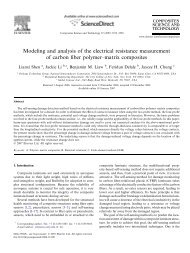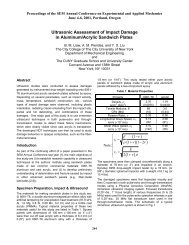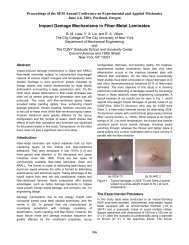Stress-Strain Relationship in Soil
Stress-Strain Relationship in Soil
Stress-Strain Relationship in Soil
You also want an ePaper? Increase the reach of your titles
YUMPU automatically turns print PDFs into web optimized ePapers that Google loves.
Adam Stock, Civil Eng<strong>in</strong>eer<strong>in</strong>g, 2012,<br />
STEP scholar<br />
Mentor: Professor Huabei Liu, Civil<br />
Eng<strong>in</strong>eer<strong>in</strong>g, The City College of New<br />
York
Education<br />
• My first year of college I traveled abroad to Israel where I spent the<br />
year study<strong>in</strong>g Jewish law, scholarly works and culture<br />
• My formal college education began at Yeshiva University where I<br />
spent 2 years study<strong>in</strong>g math and science<br />
• I transferred to City College <strong>in</strong> Fall 2009 to beg<strong>in</strong> my Civil Eng<strong>in</strong>eer<strong>in</strong>g<br />
studies
Experience<br />
• This has been my first experience <strong>in</strong> the research world, and it has<br />
taught me several important lessons already. But ma<strong>in</strong>ly I am us<strong>in</strong>g it<br />
to help me determ<strong>in</strong>e the path I want to take once I graduate from<br />
college.<br />
• I am hop<strong>in</strong>g next to become <strong>in</strong>volved <strong>in</strong> a large scale construction<br />
project to really learn how eng<strong>in</strong>eer<strong>in</strong>g is applied dur<strong>in</strong>g the<br />
construction period.<br />
• Dur<strong>in</strong>g the Summer 2009 I <strong>in</strong>terned for a small scale<br />
eng<strong>in</strong>eer/contractor <strong>in</strong> Los Angeles, California.
Abstract<br />
For every material there a maximum amount of stress or pressure<br />
that can be withstood until failure occurs, this is called the ductility<br />
of the material. Each type of soil would have a different ductility<br />
value. Currently there is no formula to determ<strong>in</strong>e the ductility of a<br />
soil, sample soil must be tested <strong>in</strong> a laboratory to determ<strong>in</strong>e its<br />
strength.<br />
Therefore we have been analyz<strong>in</strong>g test results on the stress-stra<strong>in</strong><br />
relationship <strong>in</strong> soil <strong>in</strong> order to see if we can determ<strong>in</strong>e an equation<br />
that would simplify the process of determ<strong>in</strong><strong>in</strong>g the ductility of a soil.
Project Description<br />
Goals<br />
• To determ<strong>in</strong>e if there is a correlation between the stress‐stra<strong>in</strong><br />
relationship, soil type and the po<strong>in</strong>t of failure of a material<br />
• If there is a relationship: to create an algorithm that would make it<br />
possible to determ<strong>in</strong>e the ductility of a soil us<strong>in</strong>g pure mathematics<br />
Procedure<br />
‣ Search Eng<strong>in</strong>eer<strong>in</strong>g databases for relevant data. We were look<strong>in</strong>g for<br />
either dry or saturated and dra<strong>in</strong>ed Triaxial tests.<br />
‣ Extract the relevant data and convert it <strong>in</strong>to the form required for<br />
proper analysis<br />
‣ Compare the data to determ<strong>in</strong>e if there is <strong>in</strong>deed a correlation
Background<br />
• What is a Triaxial test<br />
• A triaxial test tests the shear strength of material. The pr<strong>in</strong>cipal<br />
beh<strong>in</strong>d the test is that axial load can be different from the shear<br />
load, allow<strong>in</strong>g one to measure the stress‐stra<strong>in</strong> relationship<br />
• There are three types of triaxial test: Unsaturated; Saturated<br />
dra<strong>in</strong>ed; and Saturated undra<strong>in</strong>ed. For this project we were only<br />
search<strong>in</strong>g for the unsaturated and the saturated dra<strong>in</strong>ed results.<br />
The figure to the left depicts<br />
the load<strong>in</strong>g applied dur<strong>in</strong>g a<br />
triaxial test.
Research<br />
• In this project there were no experiments performed to compile the<br />
data. Rather the data was extracted from published articles conta<strong>in</strong>ed<br />
<strong>in</strong> the American Society for Civil Eng<strong>in</strong>eers database.<br />
• The searches focused on f<strong>in</strong>d<strong>in</strong>g any articles that conta<strong>in</strong>ed stressstra<strong>in</strong><br />
relationship data that was compiled us<strong>in</strong>g the accepted triaxial<br />
tests.<br />
• Any relevant graphs or charts were filed away to be analyzed later.
Data<br />
• The graph to the left exemplifies the<br />
stress‐stra<strong>in</strong> relationship graph.<br />
• The table shows how stress‐stra<strong>in</strong> data<br />
can be broken down <strong>in</strong>to several<br />
categories.<br />
• Both Images were taken from Prakasha<br />
and Chandrasekaran’s paper entitled<br />
“Behavior of Mar<strong>in</strong>e Sand‐Clay<br />
Mixtures under Static and Cyclic<br />
Triaxial Shear.”
Analysis<br />
• Once the data is collected the relevant data needs to be extracted:<br />
– Type of <strong>Soil</strong><br />
– Void Ration (e 0<br />
)<br />
– Conf<strong>in</strong><strong>in</strong>g <strong>Stress</strong> (σ 0<br />
/σ 3<br />
)<br />
– Max <strong>Stress</strong> (q)<br />
– Correspond<strong>in</strong>g Axial <strong>Stra<strong>in</strong></strong><br />
• Next half the value of the max stress and the correspond<strong>in</strong>g axial stra<strong>in</strong> need to<br />
determ<strong>in</strong>ed.<br />
• The max modulus is then computed as the max stress divided by its correspond<strong>in</strong>g<br />
stra<strong>in</strong>. Likewise the midpo<strong>in</strong>t modulus is computed the same way.<br />
• Many times s<strong>in</strong>ce the data is not easily accessible from the papers, the graphs need to<br />
be digitized us<strong>in</strong>g special software that turns the graphs <strong>in</strong>to easy to use Microsoft<br />
Excel data.
Interpretation<br />
• Once all the required data has been extracted and analyzed it must<br />
also be <strong>in</strong>terpreted.<br />
• We will be look<strong>in</strong>g to see if there is any correlation between soil type,<br />
density and the rupture po<strong>in</strong>t.<br />
• The first step would be to plot the data<br />
• Next we would check to see if there is an<br />
equation that could be used to it the data<br />
• Lastly, we would have to check to see how<br />
strong the correlation is to that equation
Results<br />
• This research is still on go<strong>in</strong>g and results have not yet been<br />
obta<strong>in</strong>ed<br />
• So far we have a lot of data stored away, however we would<br />
ideally like to have more data before analyz<strong>in</strong>g the data we have<br />
and mak<strong>in</strong>g a conclusion<br />
• Hopefully very soon we will be able to create an algorithm that<br />
will allow us to easily compute the failure po<strong>in</strong>t of soil materials
Acknowledgements<br />
I would like to thank Professor Huabei Liu for his help and guidance<br />
throughout the project






